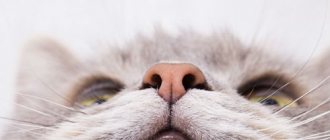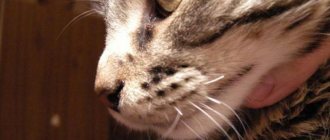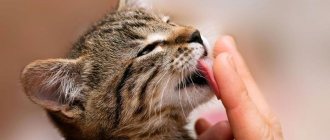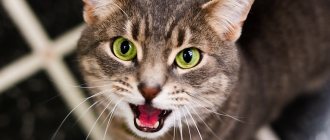Most often, the aggressive behavior of cats can be explained by their intuitive reaction to external stimuli. It is not always possible to answer the question why a cat hisses at a person unequivocally, but still, an attentive owner understands the likely reason for his pet’s dissatisfaction. Humans and cats have cohabited for centuries, and the behavioral responses of these animals have been developed throughout the evolutionary process. A hissing cat shows its displeasure, trying to defend itself or scare.
To avoid conflicts with your pet, you need to understand whether he is threatening or defending himself. For a problem-free cohabitation between a person and a pet, basic communication skills are required; to develop them, an understanding of the behavior of cats is necessary. Tense posture, facial expressions, movements of the ears, tail, paws and characteristic sounds can be a signal of the animal’s dissatisfaction.
Incorrect behavior of the owner in such a situation can cause the cat to show aggression; in some cases, it can rush at a person. The main probable reasons why a cat hisses are :
- fear;
- unmet needs;
- features characteristic of the breed;
- warning;
- pain;
- fight for territory.
Aggressiveness from fear
It happens when a cat that is quite friendly with others hisses at a certain person. This behavior is most often explained by fear and unpleasant memories of the first contact with him. For example, he inadvertently stepped on an animal’s paw or scared it in some other way. Perhaps this person is deliberately intimidating the four-legged animal, depriving it of the opportunity to retreat, trying to forcibly touch or pick it up. The cat perceives such actions as a direct threat, so it reacts aggressively - hissing.
The animal remembers once experienced stress for a long time. But the problem is easily eliminated with the help of kind words and favorite treats. The hissing of a pet can also be intuitive . If he was not handled as a child and had no human contact, the cat will probably be afraid of people as an adult. Even tamed cats can hiss at a person who is suspicious to them. That is, they proactively try to eliminate potential danger. That's why the cat hisses at strangers.
When strangers appear in the house, it is recommended to give the cat a treat, then he will associate such an event with pleasant experiences and will not hiss.
A pet may be frightened or wary of an unfamiliar noise that we have never heard, but it has excellent hearing. (He hears any rustling under the floor or behind the wall.) The cat hisses when he sees danger in a variety of situations :
- careless gesture of the owner;
- visiting a veterinarian;
- the appearance of an unfamiliar person or animal;
- strong sound or scream, etc.
When a cat hisses at its owner, there is no need to put pressure on him. – Do not pick him up or stroke him forcibly. Let him calm down first. However, this hissing is not necessarily an expression of aggressiveness; perhaps a frightened animal wants to be calmed down. Sometimes a pet feels threatened for no apparent reason. In this case, you need to distract the cat and try to calm it down. If she doesn't stop hissing for a long time, you should take her to the vet.
If a cat has hearing problems, she is constantly alert and easily frightened by the sudden appearance or touch of a person. This may also be the reason for her aggressive state.
Unsatisfied needs as the cause of hissing
In human-fed cats, hissing may be a sign of unmet needs. Signs of aggression appear in situations where the owner does not quickly respond to the needs of the pet. An irritated cat rushes or hisses at a person when it does not receive food or sufficient attention at the first request . Under other circumstances, this is an affectionate and sweet creature.
It is difficult to do something in this situation; most likely, this behavior of the four-legged animal is the result of improper upbringing.
Who else hisses like that?
Snake! The most ordinary snake! And experts say it's likely the cats didn't hiss in the first place. They simply saw enough of snakes and “adopted them,” teaching their kittens to hiss from generation to generation. The fact is that both a cat and a snake, with all their possible danger, are still very small animals... That’s why they hiss - they hope that after all it won’t come to a fight. After all, compared to something large, a cat’s chances are quite small, in fact. So it’s better to try to scare them just in case, to make it clear that you are also dangerous. What if he gets scared?
Hissing as a character trait
In some cases, a cat's hissing is a consequence of a manifestation of character. There are breeds of cats that hiss due to their inherent temperament, for example, Siamese.
Representatives of active cat breeds may hiss with insufficient physical activity.:
- egyptian Mau,
- turkish van,
- Abyssinian,
- Cornish Rex,
- oriental and others.
Most furry cats, such as Persians, do not like to be stroked after washing, and hairless cats will become angry if touched with a cold hand. In addition, hairless cats are talkative and their hissing is everyday, not necessarily an expression of aggressiveness.
Hissing is inherent in this breed
In some cases, a cat hisses because it is inherent in its breed.
Let's say Siamese hiss due to the inherent behavior of this type of temperament. Some active breeds start to hiss because they don't get enough exercise. These are Abyssinian, Oriental, Cornish Rex and some others. Some furry breeds (Persians) hate it when they wash themselves and immediately start petting them. And there are hairless cats (Egyptian breed) - they hiss constantly, because hissing is part of their conversation, and does not necessarily mean aggression.
A cat hissing in pain or foreboding
If a pet hisses at its owner for no apparent reason, it can be assumed that he is sick or that something is bothering the cat, since a cat hissing at a person for no reason is difficult to explain. The quadruped exhibits irritation in many diseases, such as :
- epilepsy;
- severe poisoning;
- hormonal changes in the body;
- injuries;
- toxoplasmosis and a number of other diseases.
A sick animal becomes frightened or irritated when approached or touched by a person. It does not want to be disturbed or is afraid of the pain that the owner can cause it without knowing it.
The hiss of a cat defending territory
Cats are by nature solitary animals who value their independence. In the house where he grew up, the cat feels like a master. When another animal appears in the home, especially a dog or kitten, the animal jealously defends its place in the house. This continues until a hierarchy is established. It is not uncommon for a four-legged animal to take out its irritation on its owner, and not on its competitor. The animal in such a situation is aggressive, this is indicated by hissing and often beating its tail.
Aggression in a cat can be caused by the smell of another animal brought from the street. A change of housing can also cause his aggressiveness, as it disrupts the usual way of life. Situations are possible when a cat defines itself as the leader in the house, then it zealously defends its position through intimidation. He hisses and shows aggression in all possible forms whenever he touches objects that he considers his own or decides that there is an invasion of his territory. In such situations, the cat often attacks people.
Why do cats hiss at other animals?
All causes of cat hissing are associated with stressful situations. The pet expresses dissatisfaction with the behavior of others. Hissing is one of the types of aggression that a pet shows towards other animals and humans. If a pet is attacked by a dog or a stronger relative, it will try to hide or run away.
But when the animal is driven into a corner, it arches its back and hisses, showing that it will defend itself to the last. When someone is about to attack or touch the kittens, the cat shows maternal aggression and drives away the intruders with sounds.
If an animal finds itself in an unusual environment among many relatives, it gets scared and hisses.
A similar development of events occurs when the following situations occur:
- Another pet has appeared in the apartment and needs to claim ownership of the territory. The newcomer can reciprocate, and the outcome of the conflict can be repeatedly postponed.
- Several cats gathered , and a need arose to redistribute places in the existing hierarchy.
- Redirected aggression: the cat was offended by someone stronger in the yard, and he decided to take his anger out on the first weaker creature that fell under the hot paw.
- The cat begins courtship earlier than expected . To which the cat, not ready for mating, responds with a hiss.
- A nursing mother raises unintelligent kittens.
Conflicts between pets may remain out of sight of the owner. But when the cat starts hissing at him, it’s time to think about why this happened and try to correct the situation.
Be sure to read:
Why cats wash themselves often: 7 main reasons, what to do if they stop licking their fur
How to calm an irritated cat
Leave the cat to recover. If another animal appears in the house, watch them, do not allow contact, let her get used to the new situation. If a four-legged hisses at a stranger, let him sniff his thing, familiarize him with his smell.
Best of all, ignore the hissing, it will be more effective than stroking your pet or screaming. Give your cat time and she will gradually calm down on her own.
The behavioral habits of pets depend on their upbringing and the attitude of their owners towards them. If it has been given enough attention and care since childhood, it will grow up to be kind and affectionate. Cats never show aggression and do not hiss without irritating factors.
Cats communicate with their owner in their own cat language, using a set of postures, body movements and sounds that must be interpreted correctly. Sometimes the signal is quite clear and logical, but sometimes a person has to resort to a “cat translator”, deciphering the cat’s actions with the help of a felinologist and zoopsychologist.
How to stop a cat from biting, scratching and hissing
Having decided to start raising a pet, the owner must monitor the condition of his pet.
Be sure to read:
Why cats love olives: is it possible to give a canned product, benefits and harm?
It is advisable to stop aggressive behavior if possible:
- shout loudly at the cat;
- make a sharp, ringing noise with a handy object;
- make a clap with your hands.
Sharp sounds will scare away the animal, forcing it to stop trying to bite the owner's hand.
You can also use a spray bottle of water, sprinkling it on the cat when biting. When trying to scratch your hand or furniture, it is recommended to use a towel or rag. You should throw a cloth over the enraged cat, thereby catching it by surprise.
"Hises like a snake"
Hissing is a very specific sound, eloquently indicating a strong negative reaction. A surge of irritation and negative emotions confirms the entire appearance of the animal:
- open mouth with demonstration of the entire combat set of teeth;
- burning eyes with dilated pupils;
- ears pressed to the head;
- an angry bristling mustache;
- raised wool.
Associated reactions. Depending on the degree of threat and personal temperament, the severity of the defensive reaction is not always the same, so a hissing cat may:
- At the next moment, quickly retreat, fleeing.
- Take a characteristic pose with an arched back and fluffy tail raised up, which means a more serious attitude and an attempt to intimidate the enemy.
- Apply several blows with a clawed paw, while grouping yourself and pressing your stomach to the ground, which symbolizes the intention to fight. The tail twitches nervously or whips from side to side.
Who is guilty. Dissatisfaction, fear and aggression, encrypted in hissing, can be directed both at a specific living object (a rival cat, a dog, a stranger) and “into space”, being initiated by a sudden loud sound or a flashing shadow. Regardless of the source, the cat's expression of displeasure, when further provoked, can develop into an attempt at violent self-defense and end in a harsh aggressive attack.
Hissing as an expression of fear and displeasure
Fear, as you know, is the most important incentive to action.
A sense of security is a cat’s most important need, and the instinct of self-preservation is the basis of survival.
A person can cause fear and fear if the cat:
- Wild and uncommunicative. In this case, the animal does not allow any people to approach itself, does not understand their intentions and does not accept human affection in principle.
- Has negative communication experiences. Unpleasant, scary and painful events from the past can leave an imprint on the current state of the animal. Sometimes a cat demonstrates associative fear and, for example, may hiss at children if it has once encountered their cruelty. Cats also remember a specific offender, expressing persistent negativity towards the person who once insulted “their tailed majesty.” Such a source of unpleasant sensations often becomes a veterinarian who gives injections to a sick animal, measures rectal temperature and performs other very unpleasant actions.
- She is not socialized and has spent her entire life communicating only with a limited circle of people. If an animal is used to living in peace and quiet, communicating only with its owner and his family, then perhaps he will be frightened by a noisy company of guests or a repair team coming to the house.
Pet behavior. Usually a frightened cat tries to run away and hide, but if, after a warning hiss, they block its path to retreat, try to touch it or pick it up, the instinct of active self-defense will kick in. Sometimes a cat hisses at its owner, frightened by a sharp gesture, sound or object in its hands. Aggressive and poorly behaved pets may react with a hiss to the lack of a desired action, for example, when the owner does not give them food or a portion of affection upon request.
Features of kitten behavior, reasons for growling
Each stage of growing up a pet has its own characteristics, including behavior. A playful kitten, no matter how tame it is, also growls and hisses at other cats, humans, unfamiliar objects, and so on. Due to his age and lack of knowledge about the world around him, he gets scared many times more often than adult cats. In addition, like all children, kittens are very emotional, which is why they often react sharply to any irritants. Therefore, they immediately take a defensive position and begin to growl, hiss, fluffing their fur and preparing to attack or escape.
The main task of the owner in the immature age of the cat is to introduce him to the world around him, teach him to interact with it, distinguish between safe and dangerous places, objects, and living beings. It is imperative to show the kitten that the owner is a friend, trustworthy and a leader who is responsible for him. This must be done gradually, patiently building a trusting relationship, without suppressing the pet psychologically and physically. With proper upbringing, the kitten will grow up to be an affectionate, kind, playful cat.
Imposing your authority on a kitten provokes it into greater aggression, forces it to go on the defensive, and leads to psycho-emotional stress for all participants in the upbringing process. This makes him more aggressive, often growls and hisses, in severe cases he lunges with his claws and fights back.
© shutterstock
Thus, it becomes clear that the young cat growls and hisses due to a lack of life experience, timidity, and emotionality. This goes away with age, he becomes calmer and more flexible.
Hissing when defending territory
It is known that cats have a reputation for being loners and individual owners, putting their independence above all else. The tamed animal considers the master's house to be its territory and is ready to zealously defend it from the invasion of strangers. It is noteworthy that competitors in the struggle for possessions may become:
- tribal cats;
- dogs and other pets;
- newcomers;
- owner and his family.
Zoo aggression is especially pronounced against the four-legged intruder.
This is why adult cats have great difficulty getting used to their newly arrived relatives. In this case, the hissing, demonstration of aggression and fights will continue until one of the rivals admits defeat, taking a subordinate place in the “pride” hierarchy.
Sharing territory with a person. Sometimes the dictator cat pours out its possessive instincts on humans. Thus, a tailed aggressor can hiss and swing its paw:
- when trying to take a seat next to you on the sofa or in an armchair;
- driving away from a plate of food;
- guarding toys, scratching posts and other items that he considers his own;
- sitting in a house or in a favorite place.
The smell of another cat, which the owner brought from the street or while visiting, can stimulate territorial aggression.
Do cats hiss in other situations?
Oh yeah. For example, on the street - looking into each other's eyes. This is how they divide the territory! They warn that it’s time to get out of their territory! As a rule, they clearly show dogs and other people’s cats: get out, or I’ll kick you out. Well, if the dog is not familiar and not your own, JoeInfoMedia journalist Diana Lynn smiles! It looks especially comical when a dog who grew up with cats tries to make friends with a street cat, and the cat hisses wildly and runs into the basement in horror...
Photo: Unsplash
Hissing as an expression of dissatisfaction and readiness to attack
The ability to see the reasons for a negative reaction and predict further actions underlies the problem-free coexistence of a person and a freedom-loving cat in the same territory. In order not to aggravate the conflict with the hissing cat, it is strongly recommended not to:
- Imposing your company on the cat and pestering it with food or toys . A pet who is in a bad mood has no time for entertainment, and his appetite at such moments noticeably worsens.
- Try to calm the cat by stroking it . At the moment of inflated feelings, a pet may react inappropriately to an outstretched hand, hitting with a clawed paw and leaving a bloody trail.
- Take the cat in your arms and cuddle it . Most likely, such an attempt will immediately fail, and the angry or frightened cat will become even more furious. Some pets may freeze for a moment in the owner’s hands, but then begin to break free with renewed vigor, dodging and using their teeth and claws.
- Block the animal's escape route . The running cat defiantly asks to be left alone. But if the owner is persistent and begins to chase the animal or tries to detain it, he will certainly cause an outbreak of aggression.
- Trying to get the cat out of hiding. A cat's house is an inviolable personal space, so there should be no intrusion from the outside. An animal huddled in a nook is in a state of stress and seeks salvation in an accessible shelter, and if it tries to bother you, it will most likely launch a serious attack.
Hissing when feeling unwell
Pain and physical discomfort are often the cause of irritation in a cat.
The survival instinct dictates that a moping animal should leave everyone, hide in a den and become quiet.
We can conclude that the cat is unhealthy if the hissing is additionally accompanied by:
- refusal of food;
- lethargy and apathy;
- weight loss and tousled hair;
- mucopurulent discharge from the nose and eyes;
- urinary retention and the appearance of blood in the urine;
- drooling, vomiting and stomach upset;
- loss of coordination, unsteadiness of gait and convulsions;
- fever and heavy breathing.
Owner's actions. In cat language, a sick animal asks to be left alone. However, you cannot let the disease take its course and hope for the legendary 9 cat lives. That is why, despite hissing and resistance, the furry pet is urgently transported to a veterinary clinic, where an examination will be carried out and the necessary tests will be done to make a diagnosis and provide qualified assistance.
Hissing as a breed trait
It has been noted that hissing may be a consequence of the breed's temperament. Thus, emotional, easily excitable cats, characterized by a quick and vivid reaction to what is happening, are prone to outbursts of emotions. These are, for example:
- Siamese;
- egyptian Mau,
- Turkish van;
- Abyssinians;
- Cornish Rex;
- orientals.
Living in isolation and lack of regular physical activity does not benefit the character of these cats, making them even more obnoxious and grouchy.
Features of other breeds. Persian and Siberian cats are very jealous of the cleanliness of their “fur coat” and can become angry if you constantly touch them with your hands. In turn, independent British people do not like hugs and cuddles, so they can hiss when treated with familiarity. And sphinxes are prone to sound outpourings and can hiss from an excess of feelings without any negative connotation.
How to stop a cat from hissing
To make the animal’s psyche smooth and stable, it is necessary:
- From childhood, accustom the kitten to hands, stroking and hugs.
- Spend as much time as possible with your pet, playing, dining and relaxing together, which will make the naturally independent creature affectionate and unable to imagine life without a person.
- Regularly perform manipulations that are unpleasant for your cat, such as brushing, bathing, cleaning eyes and ears, and trimming claws. In this case, the cat will become more docile and obedient and will tolerate such procedures without hissing or scratching.
- Socialize the cat and expand the circle of people it knows, introducing it to guests and visitors to the house. In this case, it is important that the emotions are only positive, for which visitors are armed with a treat in advance or a little catnip powder is applied to their palms.
It is important that the animal itself overcomes its fear, agrees to contact and replaces anger with mercy, since any attempts at taming will only worsen the situation. To prevent a pet’s bad mood from ending in direct conflict with bodily harm, the owner needs to be wise, correct and attentive.
Thanks to their natural abilities, cats make different sounds: meowing, purring, hissing. Large cats can also growl. In this way, animals inform humans or other fauna about their mood and readiness to defend their territory. It is important for the owner to understand the real reason for this behavior of the pet in order to avoid difficulties in communicating with him.
What does a cat express when it hisses and growls?
Communication between animals, both wild and domesticated, mainly occurs through various sounds, postures, and movements. Typically, a domestic cat experiences only positive emotions and, accordingly, behaves affectionately and purrs. When he experiences negative feelings, his behavior changes dramatically. By finding out why your pet's mood has worsened, you can easily change the situation for the better.
© shutterstock
To understand why a cat growls and hisses, you should know about the main reasons for aggression in animals. These are :
- The desire to warn a person about your bad mood or dissatisfaction. Domestic cats for the most part do not like playing with small children. Exceptions occur in cases where the parents taught the child how to play with the furry correctly. Namely, be affectionate with him, stroke him, understand that the cat is a friend and you cannot offend him. Sometimes the cat growls, warning of the danger threatening its owner. There are cases when a pet was the first to smell the gas and with its behavior saved the lives of its owners. The cat also growls loudly, sensing the approach of bad weather or an earthquake. It turns out that a cat can even help a person with its negative behavior. The main thing is to understand it in time.
- Fear is another common cause of cat aggression. An animal can be afraid of many things: from a new thing in the house to a stranger. Even an owner suddenly jumping out from around a corner can greatly frighten a pet. At the same time, a calm, generally non-aggressive cat hisses and growls in surprise. Human fear is no less common. It is relevant for a cat picked up from the street. The fear of people can last a lifetime, even if you pick up a small kitten. It is possible that he will only allow a select few to approach him, and perceive the rest as a threat. The cat will not be wild, but it will never stop behaving cautiously with new people.
- Instinctive defense of property. This category includes the cat’s area of residence, favorite resting and sleeping places, toys, food bowl and other items that the animal considers personal. It is not surprising that, in defense of his cat, he growls and hisses, thus scaring away everyone who encroaches on his personal space and things.
- Resentment or dissatisfaction. The domestic cat experiences these feelings in different situations. All furry owners are familiar with the offended look of a pet whose tail has been stepped on; this happens very often. Naturally, the cat will want to express his grievance, so he begins to hiss and sometimes growls at the offender.
- Dissatisfaction (frustration). Small kittens that are abruptly separated from their mother are most susceptible to it. They do not receive enough maternal care and milk, as a result of which they suffer emotionally. Frustration is easy to recognize. In this case, the small kitten is reluctant to make contact, but attacks the food, growls, hisses, and tries to eat everything as quickly as possible. He can also rush around the room, screaming and meowing loudly. An adult cat, in a state of dissatisfaction, becomes nervous and growls at its owner for no reason, although it perceives him as a friend.
- Manifestation of predatory instincts. Often, during the game, the cat gets so carried away that the basic instincts of his ancient predatory ancestors awaken in him. Then the cat growls, letting his wild nature take over. Just slow down the pace of the game, he will calm down and will be a cute pet again.
- Pregnancy. A cat in an interesting position needs peace, rest and maximum care. The changes occurring in her body greatly influence her behavior, and changing hormonal levels sometimes provoke frequent mood swings, increased sensitivity, and nervousness. All this leads to various manifestations of character and becomes the reason that she growls in response to certain actions of familiar and unfamiliar people.
It turns out that finding out why a cat growls and hisses will not be difficult if you take a close look at the general situation, the environment and the attitude of people towards the cat.
How does a cat make growls and hisses?
A growl is a vibrating sound produced by the four vocal muscles at the bottom of a cat's larynx. In large cats - lions, tigers, leopards and jaguars - in addition to these organs, there is also such a part of the articulatory apparatus as a flexible ligament that replaces the hyoid bone. This combination makes the “scream” so loud that it can be heard several kilometers away. Real growling is characteristic only of large cats. The rest of the family does not growl, but roars.
Maine Coon
Animals hiss while exhaling forcefully, extending their tongue in a special way and pushing their lower jaw forward. Absolutely all cats are capable of hissing, but growling or roaring is a talent that is characteristic only of some species. In particular, British cats, sphinxes, Maine coons and some others can growl.
Why do cats growl and hiss?
Predators direct their main forces to obtaining food and hunting. They are in no hurry to fight with the enemy, defending their territory, so when they meet, they first warn him of their indignation by hissing or growling. For most hissing animals, this sound is simply a warning. Sometimes it plays the role of a battle cry.
There is no beast more terrible than a cat: hissing and growling as a threat
Hissing, the cat bares its teeth and presses its ears to its head, acquiring a menacing appearance. Her fur stands up, her fangs are exposed, her claws extend. At this moment, it becomes clear to the enemy that the animal is ready to attack. With its entire appearance, it shows that it does not intend to joke, and lets the opponent know that he still has a chance to leave the territory.
How does a cat hiss?
She doesn't just make "shhhh" sounds. She also grins her muzzle, arches her tail and back, her fur stands on end, and she presses her ears to her head. At the same time, a cat can hiss in this way at any unfamiliar object, at something that moves! Do you know why? She just wants to scare this very thing! And point out that this is just a warning, that these are not active actions yet, that the cat still has his fangs and claws with him!
Photo: pxhere











